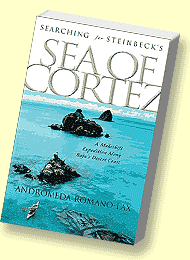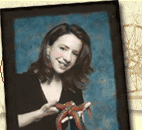|

“If
looking for life’s answers in the plankton-rich broth of a
desert tidepool sounds peculiar now, it was even stranger then.
Macho travel writers were expected to slay lions and fight bulls
in those days.”
|
|
Spring,
1940. Farmers greeted the season of birds and flowers by
blanketing their fields with the new miracle pesticide, DDT. Housewives
welcomed the introduction of pre-cooked chicken fricassee -- the
world’s first frozen dinners. RCA Laboratories unveiled the
electron microscope. The Nazis swept into Denmark undeterred. And
eager to be away from it all, to consider the world’s future
and his own, the author John Steinbeck made a trip into the Sea
of Cortez.
The world’s pace was quickening that spring, but Steinbeck
elected to slow his own life to an introspective drift. With his
closest friend, the Monterey biologist Ed Ricketts, he fled to Baja
California’s desert coast. They traveled aboard an off-duty
fishing boat called the Western Flyer. Ricketts, owner of a biological
supply company, stalked the tidepools for hundreds of specimens
to pickle and sell. Steinbeck, for whom the early 1940s were a difficult
crossroads, stalked the same habitats for ideas. Both came away
changed: shaken and reawakened to the wonders of the world.
For six weeks, the two men cruised the arid coast gathering marine
organisms, their lives governed by mechanical failures, an occasionally
ornery crew, sexual tension, and the tides. One day, they stood
calf-deep in the Sea of Cortez. Their arms were dusty pink from
the brine and the sun. Steinbeck was a meaty man -- broad shoulders,
prominent ears, brooding blue eyes. Ricketts looked elegant next
to him, with his boylike face and slender build. Both men hunched
over the water, their faces angled toward their feet, eyes squinting
into the diamond-splashed brilliance of the tropical shallows.
Small Mexican boys appeared, silent as coyotes, at the beach’s
cactus-studded margins. They carried little iron harpoons for spearing
fish. They kicked through the seaweed and tossed a few stones into
the water. They studied the two strange American men, who did not
study them back.
Finally, one of the boys -- magnetized by the men’s postures,
by the intensity of their downward stares and the delicacy of their
probing fingers -- summoned the courage to approach.
“What did you lose?” the boy asked.
“Nothing,” one of the Americans answered.
But this made no sense at all. The boy persevered.
“Then what do you search for?”
It was an embarrassing question, Steinbeck and Ricketts thought.
The two men answered it later in print -- not for the boys, but
for themselves, and for all wanderers who seek solace in the natural
world. “We search for something that will seem like truth to
us; we search for understanding; we search for that principle which
keys us deeply into the pattern for all life.”
 

If looking for life’s
answers in the plankton-rich broth of a desert tidepool sounds peculiar
now, it was even stranger then. Macho travel writers were expected
to slay lions and fight bulls in those days. Other earnest young
men were beginning to contemplate the battlefields of Europe. It
was the dawn of a dark era, and Steinbeck and Ricketts met the coming
storm by mucking about in briny puddles. They spent their days scooping
up warty, phallus-shaped sea cucumbers, and sedating writhing brittlestars.
They laughed a lot. They discussed Faust, the poet Li-Po, and Hitler.
And they drank. You had to wonder what they were up to. People,
myself included, are still trying to figure it out. Like the Mexican
boy on the beach, we want to know what Steinbeck and Ricketts were
really looking for in a tidepool. We want to know if they found
it, and whether we might find it, too.
Those questions were enough to draw me, my husband Brian, and our
two young children into a burnt wilderness for two months, following
in the Western Flyer’s historic wake. Hundreds of strange sea
creatures were the most tangible of our quarries. Two dead men were
our guides. One living (though occasionally vegetative) man was
our captain; until, briefly but memorably, he lost the will to live.
Then we were on our own.
We laughed some and drank a little -- probably not nearly enough,
because we were too distracted by each day’s challenges and
perils to risk much joyful inebriation. Though Steinbeck and Ricketts
counseled against seeking adventure of any sort, adventures often
snuck up on us just the same.
Our goal -- truth, understanding, some principle that would key
us “deeply into the pattern for all life” -- proved maddeningly
elusive. Along Baja’s desert coast, every answer led to a new
question, and every shimmering tidepool seemed to reflect how little
we knew about anything at all.
All
excerpts ©2002 Andromeda Romano-Lax
Buy
it
Read
more:
|










